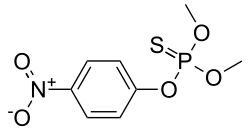Parathion-methyl
| Structural formula | ||||||||||||||||
|---|---|---|---|---|---|---|---|---|---|---|---|---|---|---|---|---|

|
||||||||||||||||
| General | ||||||||||||||||
| Surname | Parathion-methyl | |||||||||||||||
| other names |
|
|||||||||||||||
| Molecular formula | C 8 H 10 NO 5 PS | |||||||||||||||
| Brief description |
colorless solid |
|||||||||||||||
| External identifiers / databases | ||||||||||||||||
|
||||||||||||||||
| properties | ||||||||||||||||
| Molar mass | 263.21 g mol −1 | |||||||||||||||
| Physical state |
firmly |
|||||||||||||||
| density |
1.358 g cm −3 |
|||||||||||||||
| Melting point |
35-36 ° C |
|||||||||||||||
| boiling point |
154 ° C at 1.36 hPa |
|||||||||||||||
| Vapor pressure |
1.3 mPa (20 ° C) |
|||||||||||||||
| solubility |
|
|||||||||||||||
| Refractive index |
1.5367 (25 ° C) |
|||||||||||||||
| safety instructions | ||||||||||||||||
|
||||||||||||||||
| MAK |
Switzerland: 0.2 mg m −3 (measured as inhalable dust ) |
|||||||||||||||
| Toxicological data | ||||||||||||||||
| As far as possible and customary, SI units are used. Unless otherwise noted, the data given apply to standard conditions . Refractive index: Na-D line , 20 ° C | ||||||||||||||||
Parathion-methyl is an active ingredient for crop protection and a chemical compound from the group of thiophosphoric acid esters and is chemically related to (ethyl) parathion .
Extraction and presentation
Parathion-methyl by esterification of phosphorus pentasulfide with methanol , chlorination of the resulting ester with chlorine and condensation of the chlorinated ester with the sodium salt of p-nitrophenol produced.
properties
Parathion-methyl is a flammable colorless solid that is practically insoluble in water. The technical product is supplied as a brownish solution and contains 80% of the compound as well as 16.7% xylene and 3.3% inert compounds. It smells like rotten eggs.
use
Parathion-methyl has been used as a broad spectrum insecticide and acaricide in numerous crops.
Admission
In 2003, the EU Commission decided not to include parathion-methyl in the list of permitted active ingredients. In Germany, Austria and Switzerland, no pesticides with this active ingredient are permitted.
Case of poisoning
In 1999, 24 children died in the Peruvian village of Tauccamarca after drinking a milk substitute mixed with parathion-methyl. The manufacturer Bayer came under criticism because it marketed the active ingredient, which is now banned in Europe, in South America and delivered it in a simple plastic bag with a label that was only written in Spanish, although most of the residents of Tauccamarca only speak Quechua and are illiterate.
Individual evidence
- ↑ a b c d e f g h i j k Entry on parathion-methyl in the GESTIS substance database of the IFA , accessed on February 1, 2016(JavaScript required) .
- ↑ a b c Environmental Health Criteria (EHC) for methyl parathion , accessed November 19, 2014.
- ↑ a b Entry on METHYL PARATHION in the Hazardous Substances Data Bank , accessed on July 29, 2012.
- ↑ Entry on Parathion-methyl in the Classification and Labeling Inventory of the European Chemicals Agency (ECHA), accessed on August 1, 2016. Manufacturers or distributors can expand the harmonized classification and labeling .
- ↑ Schweizerische Unfallversicherungsanstalt (Suva): Limit values - current MAK and BAT values (search for 298-00-0 or parathion-methyl ), accessed on November 2, 2015.
- ↑ Decision of the Commission of March 10, 2003 2003/166 / EC: on the non-inclusion of parathion-methyl in Annex I of the Council Directive 91/414 / EEC and the revocation of the approvals for plant protection products with this active substance
- ↑ General Directorate Health and Food Safety of the European Commission: Entry on parathion-methyl in the EU pesticide database; Entry in the national registers of plant protection products in Switzerland , Austria and Germany ; accessed on March 8, 2016.
- ^ Pesticide Action Network eV (PAN Germany) - Tribunal investigated pesticide poisoning of Peruvian children ( Memento of October 3, 2015 in the Internet Archive ), January 1, 2006, Carina Weber.




